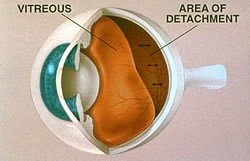
INTRODUCTION
As it is clear from the definitions generally found in medical literature, the vitreous floaters are reported as "symptoms" of a more serious problem related to the back of the eye. The appearance of floaters is in fact considered as an indication of more serious problems, leading to a detailed ophthalmologic examination of the eye with the purpose of finding a possible vitreal or retinoic condition.
In absence of the latter, such as retinal holes or detachment, the visual problems experienced by the patients are not considered as a pathology but rather as a simple nuisance for which an effective therapy does not generally exist.
The advice generally given by ophthalmologists to alleviate the annoying presence of mobile bodies in the eye involves "habit" and "compensation". The idea is that the constant presence of an alien body in the field of view should induce the brain to “absorb” it and to render its presence less obvious. Also, the presence of the disturbance in only one eye should make the process of compensation carried out by other eye simpler.
Although for many patients it is possible to get used in time to the floaters, there exists a great number of patients for whom this is not possible, and their quality of life results irremediably compromised.
Dimensions and shape of vitreous floaters vary considerably from one patient to another. Some report long filaments encompassing the whole field of view while others describe numerous tiny corpuscles
Obviously not all the situations are identical and therefore they cannot be dealt with in the same way. In the section "How we see", it is explained how the clarity of the field of vision can be seriously compromised, not only when carrying out normal activities such as reading or driving, but also causing stress and fatigue.
The presence of the vitreous bodies in both eyes, especially when of significant shape and dimensions, renders the process of “getting used to" very difficult and creates in the patient a debilitating state which is unfortunately not always recognised by doctors.
For this reason the possibilities of finding a therapy reported in the medical literature are almost non-existent. The very fact that ophthalmologists do not acknowledge this condition (and the associate debilitating state) as a pathology has not induced the medicinal science to achieve any progress in the search for effective therapies.
Some studies do exist, however isolated and pioneering, that address the problem of vitreous floaters in the absence of other more serious pathologies.
The following sections describe the few treatments available today for the treatment of floaters, nearly all not recognized as legitimate by ophthalmology. This once again demonstrates that such field is still very much unexplored but very promising if scientists would only take it more seriously.